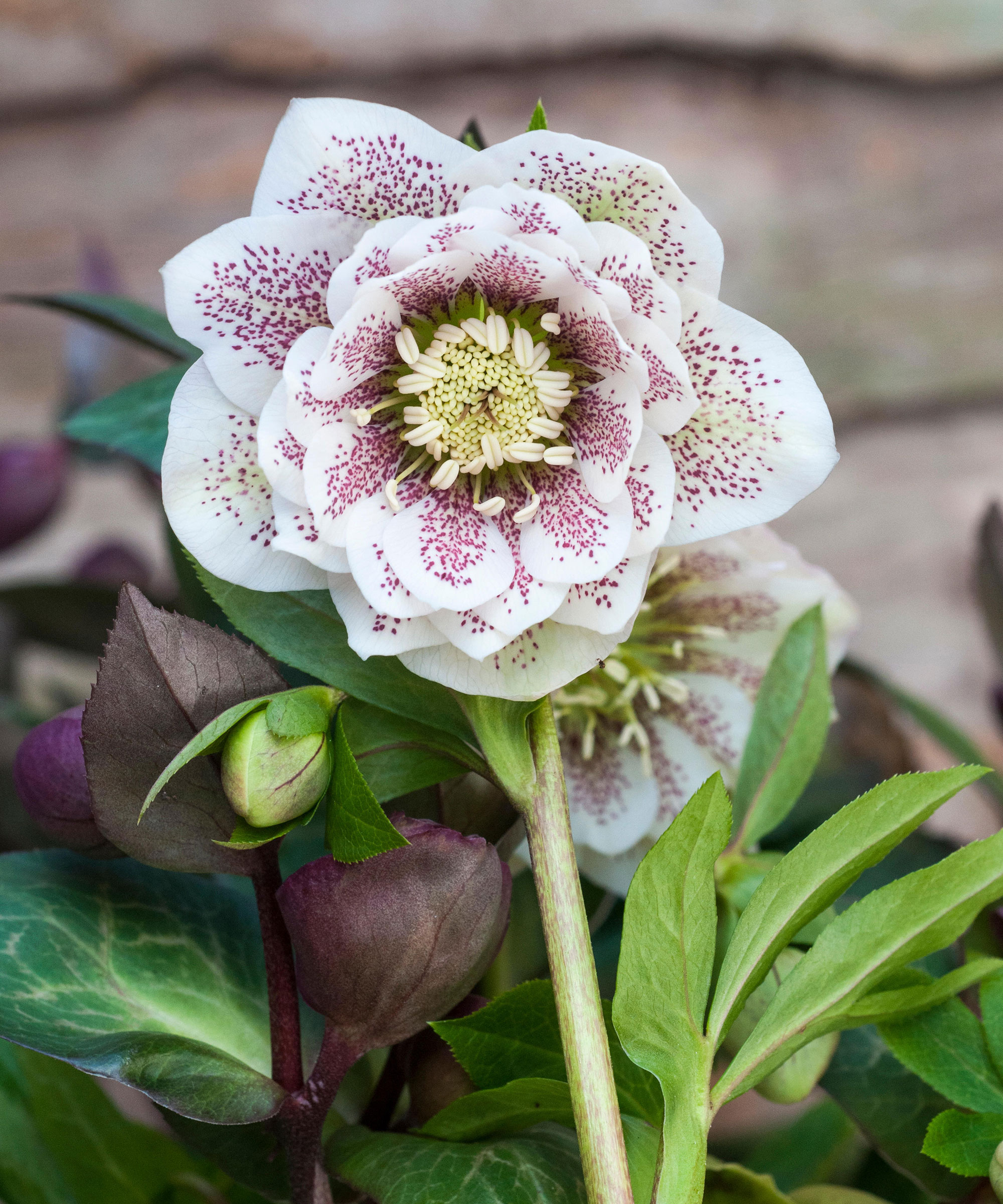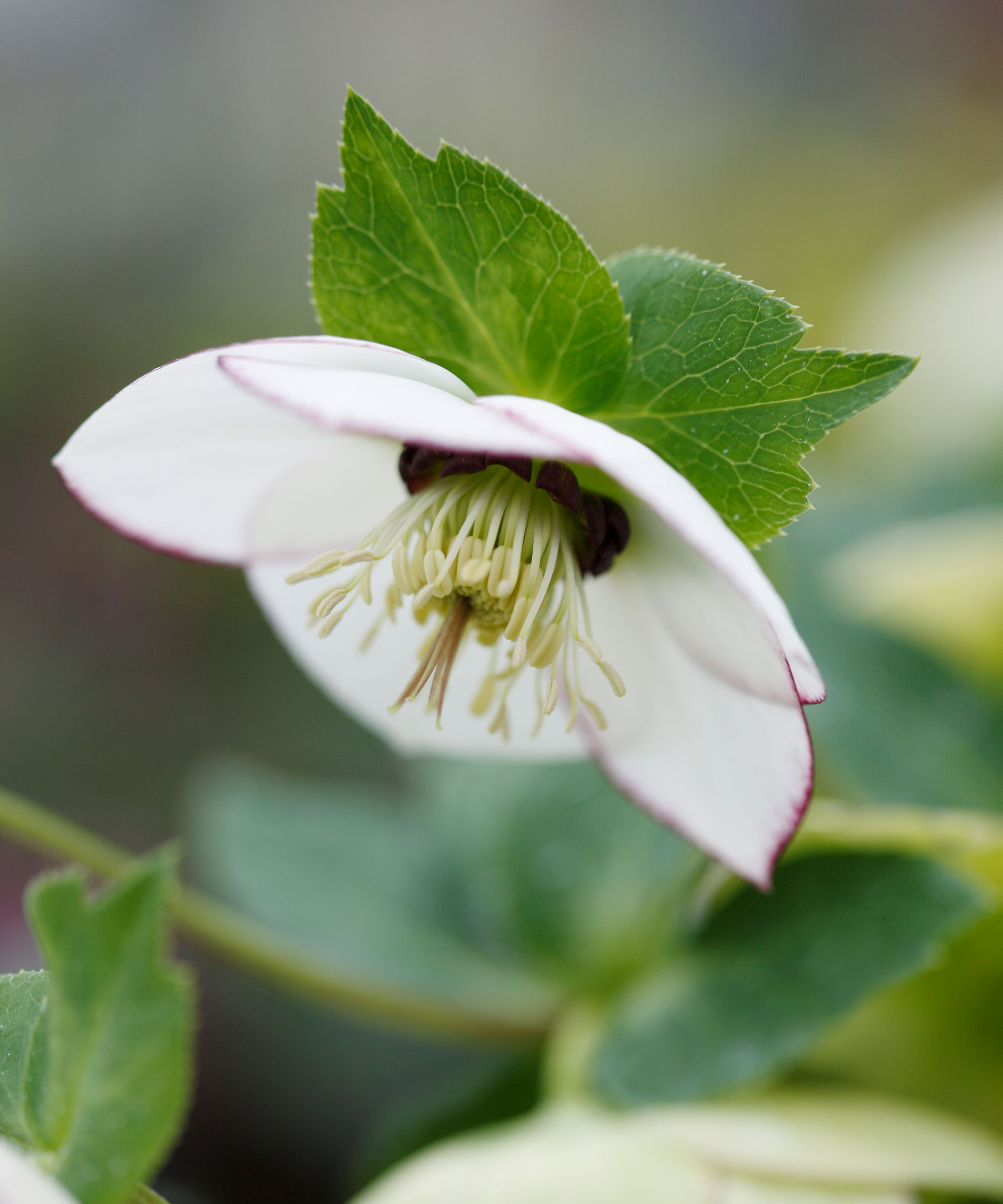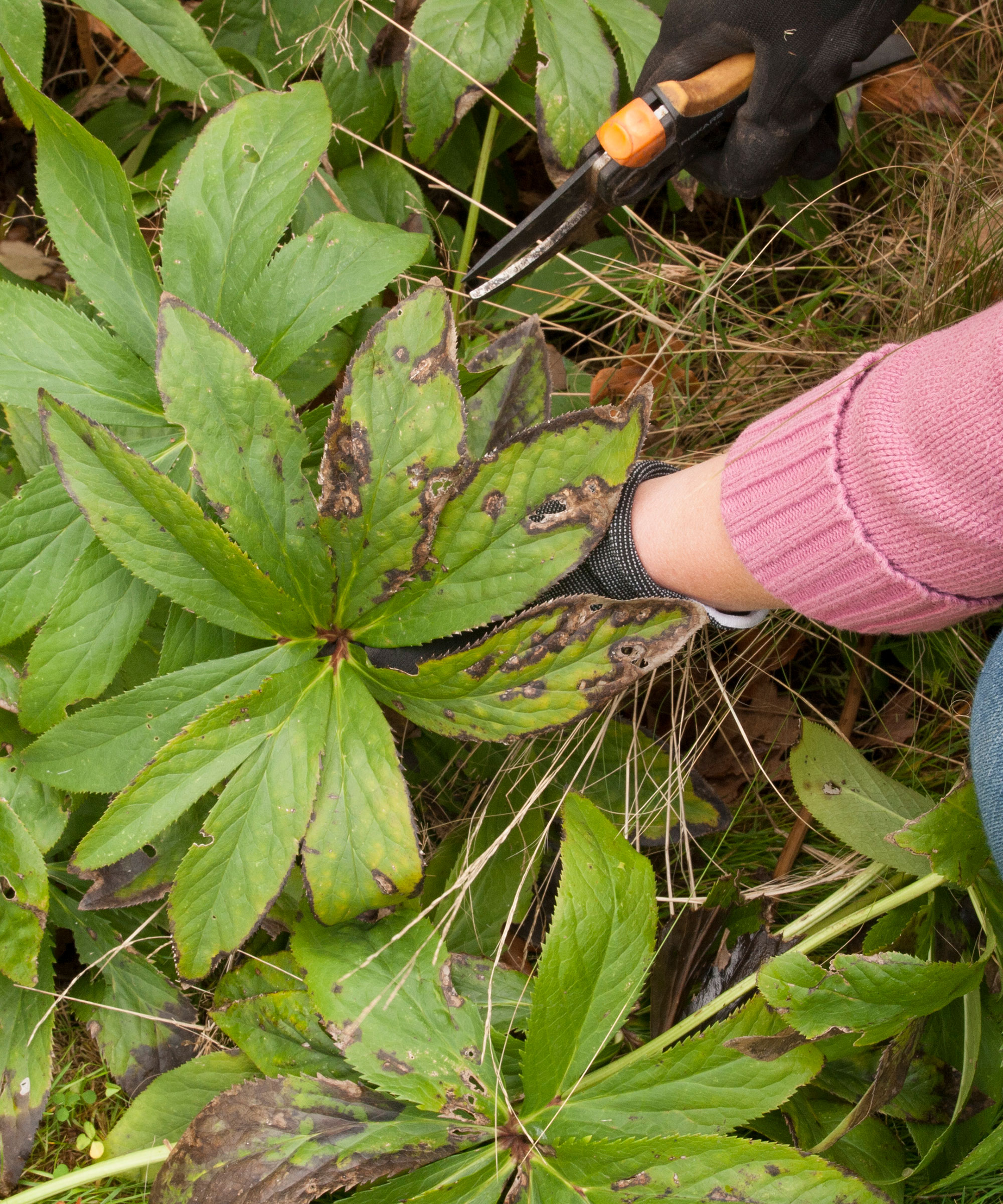Hellebores care and growing guide – expert tips for these hardy, shade-loving plants
Also known as Christmas roses, hellebores are wonderful for winter color, easy to grow, and make good options for seasonal containers


Lucy Searle
Hellebores are mainly hardy perennial, evergreen plants flowering in winter and spring. Their five-petalled flowers resemble those of buttercups but on a much larger scale, and in an extraordinary array of colors and color combinations – literally from black, through the rainbow to white with only a genuine blue missing.
As well as simple, single, bowl-shaped flowers some varieties carry fully double flowers with 20 or 30 petals and some varieties are anemone-centered – that is, with a cluster of short petals in the center of each flower. In most hellebores the foliage and flowers arise from the crown of the plant on separate stems. The large, leathery, evergreen foliage is boldly divided into at least five and often seven or nine – or even more – leaflets creating a valuable, weed suppressing ground cover.
Most hellebore varieties are shade lovers, but are remarkably tolerant of most conditions except waterlogging and long droughts. A few prefer a more Mediterranean or Californian climate. None are North American natives. The best thing, however, is that hellebores can create a continuous flower display from mid winter right through to late spring, just in time for the rest of your garden to really come to life.


Graham has a wealth of knowledge in all things horticulture. He trained at the prestigious Royal Botanic Gardens in Kew, England, and since then has written more than 20 books on plants and gardening and been a judge at the Chelsea Flower Show. He has written for a wide range of gardening magazines and websites, covering a number of features on hellebores and his favorite varieties to grow. He gardened in Pennsylvania for 20 years, but has recently returned to his native England.
Hellebores: key facts
- Plant type: Hardy perennial
- Mature size: 12-36in
- Soil type: Rich, well-drained
- Soil pH: Acid, neutral, slightly alkaline
- Time to plant: Fall, late winter, spring
- Flowering time: Winter, spring
- Flower color: Many
- Hardiness zones: USDA Z4-8 (RHS H5-7)
- Scientific name: Helleborus
- Common name: Hellebore, Christmas rose, Lenten rose
Different kinds of hellebores
Most hellebores develop foliage and flowers from the crown of the plant on separate slender stems, one divided leaf on each slightly stringy stem and a cluster of flowers on each rather fleshier flowering stem. Although the foliage of most garden hellebores is evergreen, to some extent this depends on the climate and wild hellebores sometimes have leaves that regularly die back in winter.
The most popular of hellebores, the Lenten roses, Helleborus x hybridus, are evergreen, although it is usual to cut off the old leaves in fall, before the flowering stems start to grow.
There is also a small group of hellebores that develop in a different way. Stems from 15-36in tall develop from the crown of the plant, carrying glossy leathery leaves at intervals up the stems, then develop a cluster of usually green flowers at the top.

How to choose the right hellebore for your yard
'Flowering between mid winter and late spring, depending on your climate, hellebores are prized for their sturdy, undemanding temperament and the striking colors and beauty of their flowers,' say hellebore experts Ernie & Marietta O’Byrne of Oregon’s Northwest Garden Nursery.
Design expertise in your inbox – from inspiring decorating ideas and beautiful celebrity homes to practical gardening advice and shopping round-ups.
- Hellebores for shade Lenten roses, Helleborus x hybridus, the most widely grown hellebores, thrive as shade plants in most areas although they prefer dappled shade or shade for part of the day. For that reason, they work well as a woodland plant. In areas with cool summers and where the soil does not dry out for long periods they will take more sun – in fact the more consistently moist the soil, the more sun the plants will take. The Christmas rose, Helleborus niger (available from Monrovia), also appreciates some shade. The stinking hellebore, Helleborus foetidus (ignore the unfortunate name), prefers the shade of mature deciduous trees or large shrubs, or the shade from the heat of the day provided by a garden wall or fence. Its small green bells are edged in red and the dark, narrowly divided foliage is attractive for most of the year. This is a type with leaves and flowers on the same stem.

- Hellebores for sun In many cooler areas, Lenten roses will do well in full sun but there are also a few that will only thrive in plenty of sunshine. The Corsican hellebore, Helleborus argutifolius, is a tall type with woody stems carrying bold, leathery leaves and topped with prolific heads of large green bowl-shaped flowers. A similar, but much smaller, type, the Majorcan hellebore, Helleborus lividus, has greyish leaves and pink tinted flowers. The hybrid between the two, Helleborus x sternii, combines their features and is a delightful, though short-lived plant.

When to plant hellebores
'Since these plants do not actively grow in warmer temperatures, we feel fall planting is far superior to planting in April or May,' says hellebore expert Judith Knott Tyler of Pine Knot Farms in Virginia.
Hellebores can be planted at any time between fall and the end of flowering, as long as the soil is neither frozen or waterlogged. Fall is best. Many hellebores are bought while in full flower, so plant them as soon as possible. If the ground is frozen, keep the plants in a sheltered place until the soil is frost free.
Choose a shaded or a sunny site according to your location and the type of hellebore you are planting.

How to plant hellebores
Lenten roses, in particular, are long-lived plants that appreciate thorough preparation – in fact it is sometimes suggested that preparation should be as if you were planting a tree.
Dig a hole the depth of your spade, loosen the soil in the base of the hole and mix in plenty of organic matter such as garden compost then set the plant so that the crown is the same height as the surrounding soil. Fill in the hole with more soil-compost mix, firm well, water with liquid feed and mulch with bark or other weed-free organic matter.
Hellebore care tips
Most hellebores are tough and resilient plants. But although they will usually flower with little care or attention, flowering will be so much more colorful and prolific, and the clumps will develop more quickly, if they receive a little care.
- Watering and feeding Watering plants in dry spells in summer always helps. In addition, knowing how and when to fertilize hellebores is important, typically done in the spring after flowering with a dose of general fertilizer. You can feed again in the fall before renewing your preferred type of mulch, which encourages the plants to develop at a time when the roots are growing strongly.
- Mulching Renew the mulch in the fall if necessary.
- Deadheading As the flowers lose their intense coloring and develop green overtones, the seed pods will start to fatten in the middle of each flower. When seed pods are developing in each flower in the cluster, cut the stem out at the base. This will prevent the plants self-seeding – self-sown plants are usually poor shadows of their parent plants.
- Foliage removal In the late fall, as the clusters of fresh new flower buds are emerging at the base, cut off all the foliage at ground level using pruners or kitchen scissors. This is to prevent the leaves carrying disease over from one year to the next and infecting the emerging flowers.

How to make more hellebores
There are two ways of making more hellebores: one is easy and reliable, the other is slow and unpredictable. The best approach is to lift and divide the plants in the fall, and replant the pieces.
To do this, dig up the plant using a garden fork. This may turn out to be a bigger job than you expect as the roots may go deep. Next, use a hosepipe on a gentle setting to wash all the soil off the roots. The crown and roots will now be clearly visible and you can use pruners to cut the plant into pieces – each with leaves and roots. It is easiest to cut the plant into two or three pieces, cut off all the leaves, and replant them in your flower bed straight away. Alternatively, cut the plant into more, smaller, pieces and grow them on in pots for a year before planting. Dividing your plant will ensure that your new plants are identical to the original.
If you leave the flowers to develop seeds, harvest them when they turn black, and sow them at once. You should have flowering plants in three years – but there is absolutely no guarantee that the new plants will resemble their parent.

Hellebore problems and how to solve them
Hellebores are generally problem-free but are sometimes troubled by pests or diseases.
- Mice Generally, mice do not trouble mature plans but, if you raise new hellebores from seed, they may well dig up the seeds and eat them. Sow in pots and protect the seeds.
- Slugs They may eat hellebore seedlings, or the flower buds as they emerge from the soil, and may even climb the flower stems and eat the buds of developing flowers. Protect the plants by getting rid of slugs with an organic slug treatment, try Amazon.
- Aphids Clusters of aphids sometimes feed on the backs of the foliage or in the flowers. Treat with an organic insecticide.
- Leaf spot Black blotches disfigure the buds, flowers and foliage. Cut off all the foliage of Lenten roses and other stemless types in fall to prevent disease carry-over from one season to the next.

Growing hellebores in pots
We love growing hellebores as part of our container gardening ideas because you can move them towards your backyard door in cold weather – then hide them further down the yard in the summer months when they're less interesting.
When planting in containers choose a heavy pot made of terracotta, stone or concrete as the weight of the pot will help keep the plant stable. Plastic pots are usually too light. Ensure the pot drains well and use rich but well-drained potting soil. Keep the pot topped up with compost to encourage continual healthy growth and flowering.
A few hellebores make great winter plants for pots, especially the Ice ‘n’ Roses Series, available from Monrovia, and the Rodney Davey Series that combine colorful flowers with prettily patterned foliage. ‘Penny’s Pink’ and ‘Anna’s Red’ are especially well-worth seeking out along with dwarf forms of grey-leaved Helleborus x sternii.
Another tip that's apposite to planting hellebores in pots: remember that with many hellebores the flowerheads droop downwards, so use the flexibility of container planting to position your hellebores where the flowerheads can be seen – perhaps on a windowsill, in a raised garden bed or on top of a low wall.

Pruning hellebores
Ideally, prune hellebores in later winter/early spring when new growth appears. This growth will manifest as little stalks which will still be surrounded by a ring of older, larger leaves that may be a little damaged or bedraggled from last year's cold weather.
It's these older, damaged leaves that you can remove to make room for the new growth. Old leaves that still have a pleasing shape needn't be pruned, unless they have any signs of disease (check the undersides, too) but can be left until new leaves start to appear. Leave things too late, though, and the new and old growth will become indistinguishable and difficult to separate.
For aesthetic reasons, pruning away excess foliage also allows the hellebores' blooms to shine.

Should hellebores be deadheaded?
No one likes to look at old flowers, and deadheading can benefit a plant's growth. It's easy to deadhead hellebores: simply carefully snap off the old flower stems when they start to decline and before they set seed, taking them back to the base of the stem. There are exceptions to this rules – the Bear's Foot, which should be left alone.
Which USDA zones do hellebores grow in?
- Winter temperatures mainly govern where the different hellebores will grow, but few are happy in zones warmer than Z8, where all hellebores are hardy. The Lenten rose, Helleborus x hybridus, will also grow in Zone 9 and is hardy down to Zone 4.
- Christmas rose varieties, Helleborus niger, are hardy down to Z3 or Z4, some will take Z9.
- Stinking hellebore, Helleborus foetidus, will also grow in Z9 and is reliably hardy down to Z6.
- Corsican hellebore, Helleborus argutifolius, is hardy down to Z6 but will take Z8-10 depending on the variety. Helleborus x sternii will take Z7-Z9, depending on variety.
- The Ice ‘n’ Roses Series and the Rodney Davey Series are all hardy down to Z5 and happy up to Z8.
Are hellebores deer resistant?
Yes, mostly. The New Jersey Agricultural Experiment Station, who have researched deer-resistant plants and rated them in four categories of deer resistance, have assessed hellebores and rate them as 'Rarely Damaged'.
This places hellebores in the most resistant of their four categories. But it is important to realize that in severe winters, when food is very scarce, hellebores may be eaten if the foliage is not removed in fall and remains above snow cover.
Does the stinking hellebore really stink?
The flowers of the so called stinking hellebore, Helleborus foetidus, do not have a fetid smell, although they can sometimes smell a little catty. In fact, in the past, varieties have been selected for their sweetly smelling flowers but these are hard to find.
The disagreeable smell is only found when the leaves are broken, the smell is in the plants’ sap. So if you never damage the foliage, you will never notice the bad smell.
How to buy hellebores
Hellebore seeds are rarely sold by the familiar flower seed companies because they must be sown very quickly after they have ripened on the plant, otherwise very few seeds will sprout – often none at all. So do not buy hellebore seeds to sow yourself.
Hellebore plants are sold in bud or in flower in local high end nurseries and retail outlets. They are slow and expensive to propagate on the nursery so are often more expensive than other hardy perennials of the same size. If plants are offered before they flower, be sure to check the tag carefully to be sure you’re buying the color you prefer.
A far wider choice is available mail order and plants are offered in a range of sizes: packs of six cells are the most economical but the plants will take a year or two to come into flower. Plants are also offered individually in 4in pots or 1 quart pots. Large plants, often in full flower, are sometimes available in larger pots.
- Shop hellebore plants at Amazon
- Shop hellebore plants at Burpee
- Shop hellebore plants at Monrovia
- Shop hellebore plants at Nature Hills
- Shop hellebore plants at Pine Knot Farms

Graham Rice is a garden writer who has won awards for his work online, and in books and magazines, on both sides of the Atlantic. He is a member of a number of Royal Horticultural Society committees and the recipient of the 2021 Garden Media Guild Lifetime Achievement Award. He gardened in Pennsylvania for 20 years, but has recently returned to his native England.
- Lucy SearleGlobal Editor in Chief